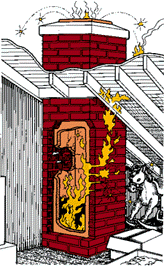A Guided Tour Of Your Chimney

|

It happened thousands of times last year - chimney defects resulted in home fires.
It doesn't take much to start a home fire...a spark flitting through a crack in the chimney wall into the attic...a chimney ember igniting a creosote fire which then climbs the full height of the chimney "looking" for a breech in the chimney wall...or simply excessive heat reflected through chimney walls when a clay liner is missing or damaged.
With continued use of this chimney, any of these conditions could lead to loss of property or life.
Fortunately, the problems of a deteriorating chimney can be corrected without completely rebuilding your chimney.

|

Chimney Terms
Stainless Steel Chimney Liner
Stainless steel pipe, either rigid or flexible, made for relining flues of masonry chimneys when the original clay liner has cracked or broken. May also be used to create a lining in a masonry chimney that was made without a clay liner.
Chimney Caps
Protective coverings for chimneys usually made of aluminum, galvanized or stainless steel, or copper. Most chimney caps have a mesh screening that serves the dual purpose of spark arrestor and barrier against animals. Chimney caps also prevent rain from entering the flue of the chimney.
Top-Sealing Dampers
A device installed at the top of a chimney for the purpose of sealing the flue shut when the fireplace is not in use. They are often used as replacements for throat dampers that are installed just above the firebox when a masonry chimney is built. Lyemance and Lock-Top top-sealing dampers are as much as 90% more efficient than throat dampers because they provide a silicone rubber gasket seal rather than metal to metal.